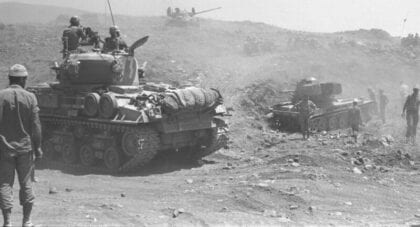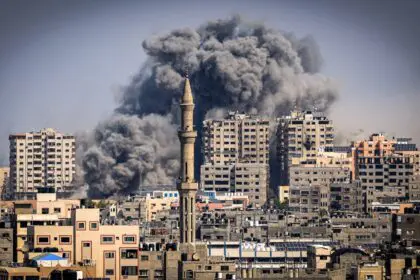Operation Protective Edge is not the first war Israel has waged on Gaza. Israel had previously launched two similar operations: Operation Cast Lead (2008) and Operation Pillar of Cloud (2012). No matter what name a Hamas-Israeli war was given or what reasons were given for it, it has always been the civilians of Gaza who have paid the price.

According to the United Nations, more than 452 children are killed by Israel during the war on Hamas in 2014 / Photo by CORBISThe Israeli campaign against the rocket attacks from Gaza seemed to be a turning point for the two factions of Palestinian political life.
Before Israel’s 8 July military offensive “Protective Edge” in the Gaza Strip, Gaza’s Hamas rulers were facing the worst crisis since the taking control of the territory seven years ago: the 50,000 civil servants of the disbanded Gaza government had not been paid their salaries for several months; the new unity government run by the Palestinian National Authority (PNA) was unable to pay the monthly salaries of Hamas staff in the PNA-operated banks in the Gaza Strip, after being threatened by the Israeli government with halting the transfer of taxes to the newly sworn-in unity government; obstacles to reconciliation remained in place; and a poll, published by the Ramallah-based Palestinian Center for Policy and Survey, showed a sharp decline in Palestinians’ support for the de facto Hamas government, due to its inability since 2007 to provide minimal services in the Gaza Strip.
The Israeli offensive, which ended 26 August has, however, changed the situation markedly. Palestinian support for Hamas has increased. People stand with Hamas, which prompted the Palestinian leadership of President Abbas and the Palestinian Liberation Organization (PLO) to express their support for the resistance in Gaza and back its truce demands, including lifting the blockade in all its forms, freeing all Palestinian prisoners re-arrested after their release in the Gilad Shalit exchange deal, and expanding the waters accessible for fishing and removing the no-go zones.
Israel’s bitterest enemy, Hamas, was thus being marginalised but is now central to any future arrangements in Palestine. Israel’s most reliable peace partner, Abbas, has been weakened and marginalized and may not be able to recover without massive Western and Egyptian intervention.
After Egyptian army chief General Abdel Fattah al-Sisi deposed Egyptian President Mohammed Morsi and his party, the Muslim Brotherhood, in July 2013, Hamas was the biggest loser. Taking off the gloves, the Egyptian Army destroyed Gaza’s extensive network of smuggling tunnels under the Gaza border to stop goods (including food and building materials), weapons, and money coming into Gaza through the tunnels. The demolition of the tunnel network and the virtual closure of the official Rafah border crossing has had a negative impact on many livelihoods, such as labor, distribution, and the supply of materials to the construction industry. Hamas also lost income from taxes on goods coming in through the tunnels.
Becoming more isolated and apparently vulnerable, the Gaza-run government made an about-face in its policies after downfall of the Muslim Brotherhood, which has shaken the entire region. The chances that the Muslim Brotherhood will rule again and lift the blockade are slim. Left with no option, Hamas accepted the reconciliation agreement with Fatah, to share the burden of government, in the hope of keeping alive the Palestinians’ support for armed resistance.
The Palestinian leadership has been widely criticized during the war for its continuing coördination with Israeli security forces in the West Bank and because it only reluctantly sided with the Islamic militant group in Gaza.. The broad popular support for Hamas and Islamic Jihad forced several PLO senior figures to issue hard-line statements against Israel and the United States, praising the fighters. The PLO’s executive committee secretary general, Yasser Abed Rabbo, said “the victory of the resistance in Gaza is a victory for the Palestinian national project, and its defeat would be an end of the dream for the Palestinians reaching out for freedom and independence.” Yasser Abed Rabbo called a meeting of the leaders of the factions, in which Hamas and Islamic Jihad participated, to decide on a united Palestinian agenda for the next phase. In an official statement, the PLO called for widespread protests in solidarity with Gaza and asked its security officers not to suppress protests supporting the Gazans.
Immediately after the war, analysts thought it could have a positive impact on the Palestinian reconciliation talks. President Mahmud Abbas, who was reluctant to proceed with reconciliation before the outbreak of this devastating war, has been forced to express solidarity with Hamas and back its demands, as the legitimate demands of all Palestinians. Some observers believe that President Abbas could be forced to take further steps to push for reconciliation with Hamas and the resistance that are supported by a large part of the Palestinian people and to defend their demands—lifting the blockade, reconstructing the Gaza Strip, and finding a solution for the non-PNA (Hamas) employees. But later Abbas revised his position and refused to agree to make concessions to Hamas, which by mid-September faded hopes for real progress towards reconciliation.
The grounds of public hospitals in Gaza have become home to dozens of families whose houses have been leveled by the Israeli artillery during Israel’s offensive in July-August 2014. Gaza schools, which were preparing for the upcoming academic year, have also been turned into crowded shelters for those who fled Israel’s invasion of their towns.
Gaza’s hospitals are complaining due to running out of space because of the influx of wounded patients. Israeli air strikes have destroyed the Strip’s power and desalination plants, plunging entire towns in into darkness and leaving civilians without adequate drinking water.
These are just a couple of examples of what Gaza civilians are going through because of the war Israel waged on Hamas under the name “Operation Protective Edge.” The Israeli government, headed by Benjamin Netanyahu, claimed that the operation was aimed at deterring Hamas, protecting Israelis from the rockets of the Palestinian resistance, and restoring calm and security in Israeli territories.
The humanitarian situation in the Gaza Strip, however, tells a different story. Civilians are paying the highest price for this war. Huge numbers of Palestinian civilians have been killed and injured since the day Israel’s missiles started lighting up Gaza’s skies. According to the Palestinian Centre for Human Rights (statistics published on 27 August 2014), Israeli airstrikes and artillery have killed more than 2100 Palestinians, including 519 children and 297 women, and injured more than 10,800.
Operation Protective Edge is not the first war Israel has waged on Gaza. Israel had previously launched two similar operations: Operation Cast Lead (2008) and Operation Pillar of Cloud (2012). No matter what name a Hamas-Israeli war was given or what reasons were given for it, it has always been the civilians of Gaza who have paid the price.

Destroyed Houses and Displaced People
Operation Protective Edge has had catastrophic results for the civilians in Gaza. Entire neighborhoods in Shujaaiyya, Khuzaa, and Rafah have been wiped out by Israeli shelling and airstrikes. Israel claims that it targeted those areas in search of the tunnels and arm caches used by Hamas to attack the Israeli army. The strikes turned hundreds of Palestinian families homeless, as they fled their homes seeking refuge in the schools run by the United Nations Relief and Work Agency (UNRWA), and in churches and public hospitals.
According to the 42nd UNRWA report (dated 19 August 2014) on the situation in Gaza, since the beginning of the Israeli operation, more than 238,000 displaced Palestinians have been sheltered in 81 UNRWA schools. The UNRWA adds that about 100,000 Palestinians have lost their homes. Based on these figures, UNRWA expects about 70,000 Palestinians to remain in UNRWA schools indefinitely, as their houses have been destroyed.
Although many saw UNRWA schools as safe havens, some of these schools were, in fact, the targets of several Israeli airstrikes in Beit Hanoun, Rafah, Jabaliya, and al-Magazi refugee camp. Such attacks were strongly condemned by Ban Ki-moon, the UN Secretary General, and increased international criticism of Israel.
Speaking about the efforts of reconstruction in Gaza, Palestinian Minister of Public Works and Housing Mufid al-Hasayneh said in mid-August that 20,000 houses had been completely destroyed or severely damaged by the Israeli shelling and that forty thousand houses, had been partially destroyed or had light or moderate damage.
Panic attacks and traumas
Many Gazans are suffering psychological trauma as a result of the violence they have been exposed to during the Israeli strikes. Dr. Yaser Abu Jamea, director of the Gaza Community Mental Health Programme, said in an interview that more and more Gazans were showing psychological symptoms such as stress, anger, and insomnia and that many people in Gaza have experienced severe psychological shock from the loss of family members. A recent UNICEF report mentioned that about 400,000 Palestinian children in Gaza were in need of psychological and social support for psychological symptoms such as bedwetting, nightmares, and excessive attachment to parents.
A Struggling Healthcare Sector
According to Dr. Mahmoud Daher, the Gaza representative of the World Health Organization, the Strip is experiencing a major shortage in medicines and medical supplies. Dr. Daher says that the last Israeli war had aggravated healthcare problem in Gaza to the point where WHO had to appeal to several international institutions to provide Gaza hospitals with urgent medical aid. Several hospitals in Gaza were the targets of recent Israeli airstrikes, and several, including al-Wafa Hospital, have been completely destroyed. Two Red Crescent paramedics were killed and many paramedics injured while doing their jobs.
No electricity, no water
On 29 July, Israeli airstrikes bombed Gaza’s only power plant out of operation and destroyed the main electricity lines coming from Israel, causing a complete blackout in the Strip. The power cut, in turn, paralyzed the sewage system, and the Gaza municipality warned citizens that entire neighborhoods might be flooded with sewage water. “Due to the war on Gaza, the municipality is unable to provide the fuel necessary for the power plants; it needs more than 15,000 liters of fuel daily in order to operate and pump water,” Gaza mayor Nizar Hijazi said. According to Hijazi, the power cut has disabled more than 200 water wells, which severely curtailed Gaza’s water supply.
Severe Economic Losses
The Israeli offensive has had a devastating impact on Gaza’s economy. Palestinian Deputy Minister of Economy Tayseer Amro estimates Gaza’s economic losses due to the war at USD 4 to 6 billion. He told al-Hayat al-Jadida newspaper that donors were scheduled to meet in Norway in September to discuss funding reconstruction projects in the Strip.
Many industrial facilities were the targets of recent Israeli airstrikes. Ali al-Hayek, chairman of the Palestinian Industrial Federation, told al-Iqtisadiya magazine that losses in Gaza’s industrial sector due to the war had reached about USD 1 billion and that the construction, paper, chemical, and mineral industries had been severely damaged. Moreover, losses of Gaza’s food industry amounted to about USD 150 million, according Tayseer al-Safadi, to the head of Gaza’s Federation of Food Industries.
It is clear to economists that these Israeli attacks on Gaza has added considerably to the economic burdens of the people, the private sector, and the budget of the Palestinian Authority, and that the PA will have to deal with such extra expenses as aid for the families of those who have been killed, medical treatment for the injured, housing for the displaced, and reconstruction expenses.
History of the Palestinian-Israeli Conflict
This article is part of our coverage of the history of the Palestinian-Israeli Conflict.
Fanack’s historical record meticulously chronicles the Palestinian-Israeli Conflict in a chronological sequence, encompassing its origins, crises, wars, peace negotiations, and beyond. It is our most exhaustive historical archive.



